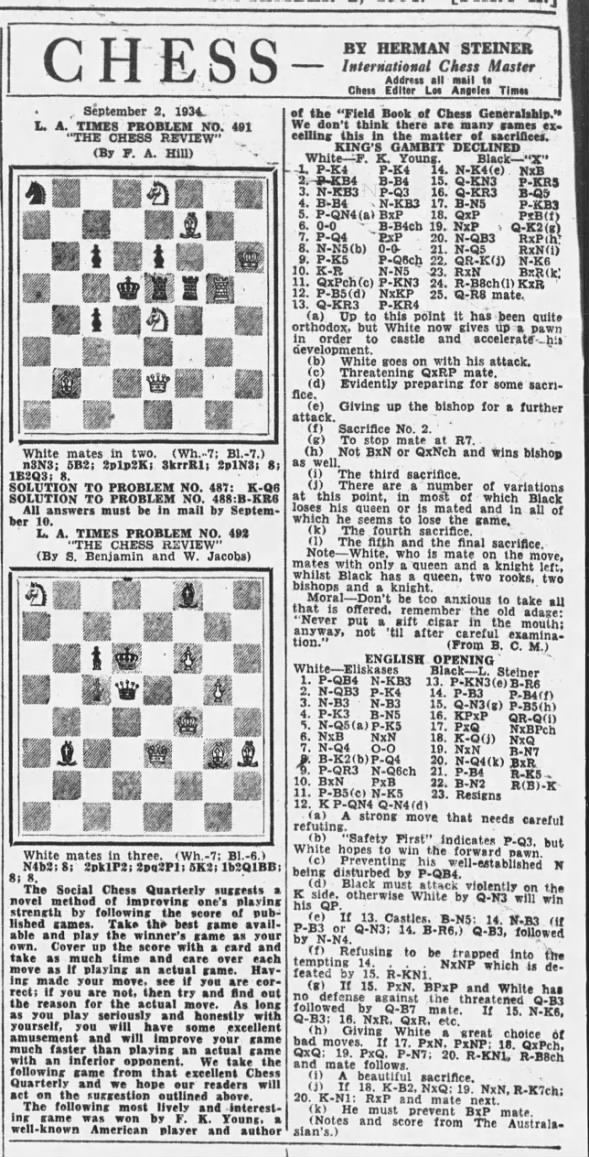 Chess by Herman Steiner 02 Sep 1934, Sun The Los Angeles Times (Los Angeles, California) Newspapers.com
Chess by Herman Steiner 02 Sep 1934, Sun The Los Angeles Times (Los Angeles, California) Newspapers.com
The Los Angeles Times Chess by Herman Steiner Sunday, September 02, 1934 Los Angeles, California L.A. Times Problem No....
Posted by Bobby Fischer's True History on Wednesday, August 18, 2021
L.A. Times Problem No. 491 by “The Chess Review” by F.A. Hill. White mates in two.
FEN n3N3/5B2/2p1p2K/3krrR1/2p1N3/8/1B2Q3/8 w - - 0 1
Key: Q-B3/Qf3
The Los Angeles Times Chess by Herman Steiner Sunday, September 02, 1934 Los Angeles, California L.A. Times Problem No....
Posted by Bobby Fischer's True History on Wednesday, August 18, 2021
L.A. Times Problem No. 492 “The Chess Review” by S. Benjamin and W. Jacobs. White mates in three.
FEN N4b2/8/2pk1P2/2pq2P1/5K2/1b2Q1BB/8/8 w - - 0 1
Key: Q-Q2/Qd2
The Social Chess Quarterly suggests a novel method of improving one's playing strength by following the score of published games. Take the best game available and play the winner's game as your own. Cover up the score with a card and take as much time and care over each move as if playing an actual game. Having made your move, see if you are correct; if you are not, then try and find out the reason for the actual move. As long as you play seriously and honestly with yourself, you will have some excellent amusement and will improve your game much faster than playing an actual game with an inferior opponent. We take the following game from that excellent Chess Quarterly and we hope our readers will act on the suggestion outlined above.
The following most lively and interesting game was won by F. K. Young, a well-known American player and author of the “Field Book of Chess Generalship.” We don't think there are many games excelling this in the matter of sacrifices.
Franklin Knowles Young (White) vs. X (Black)
King's Gambit Declined: Classical Variation
(a) Up to this point it has been quite orthodox, but White now gives up a pawn in order to castle and accelerate his development.
(b) White goes on with his attack.
(c) Threatening QxRP mate.
(d) Evidently preparing for some sacrifice.
(e) Giving up the bishop for a further attack.
(f) Sacrifice No. 2.
(g) To stop mate at R7.
(h) Not BxN or QxNch and wins bishop as well.
(i) The third sacrifice.
(j) There are a number of variations at this point, in most of which Black loses his queen or is mated and in all of which he seems to lose the game.
(k) The fourth sacrifice.
(l) The fifth and the final sacrifice.
Note—White, who is mate on the move, mates with only a queen and a knight left, whilst Black has a queen, two rooks, two bishops and a knight.
Moral—Don't be too anxious to take all that is offered, remember the old adage; “Never put a gift c*g*r in the mouth; anyway, not 'til after careful examination.” (From British Chess Magazine).
Erich Eliskases vs Lajos Steiner
11th Hungarian National (1933), Budapest HUN, Apr-??
English Opening: King's English. Four Knights Variation Quiet Line (A28) 0-1






















